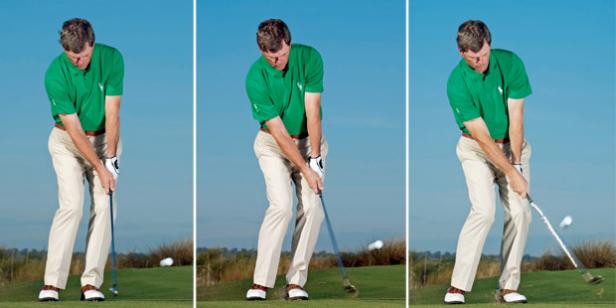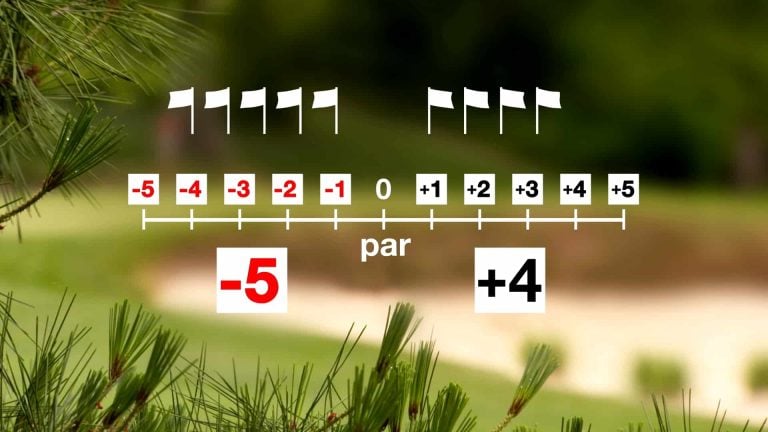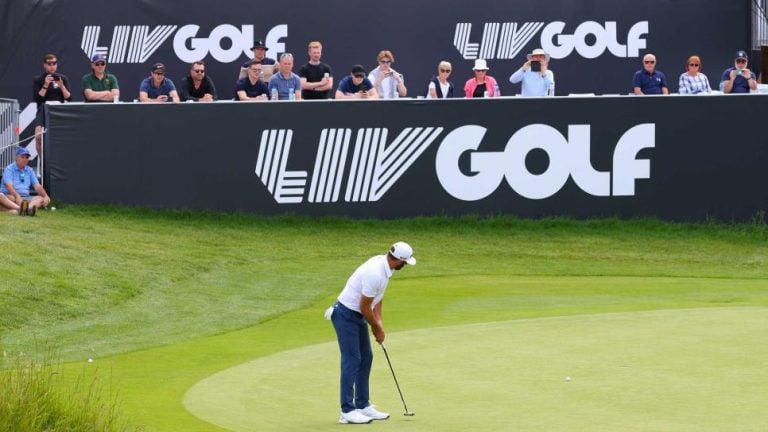Golf How to Pitch: A Step-by-Step Guide to Improve Your Short Game
Key Takeaway:
- Pitch shots are an essential part of golf and understanding the difference between chip shots and pitch shots is crucial for success.
- Proper setup and posture, including selecting the right club and maintaining balance, are key techniques for executing successful pitch shots.
- To enhance pitch shots in specific situations, players can increase ball height by selecting suitable wedges and utilize wrist hinge for launching the ball.
Introduction
Golf pitching is an important skill for any golfer to have. It involves hitting the ball a short distance, usually 10 to 50 yards, with precision and control.

The right grip is key for golf pitching. It should be firm but not too tight. The stance should be balanced and aligned with the target. The swing should be smooth and have a wrist hinge for added power.
Choosing the right club is also essential. Golfers need to select a lofted club, like a pitching wedge or a sand wedge, depending on the conditions of the shot. Wind direction, green slope, and hazards should all be taken into consideration.
Practicing different pitching techniques can improve a golfer’s skills. For example, mastering the flop shot allows players to hit the ball high. The bump-and-run shot is great for long distances on the green.
Studying and practicing pitching techniques can improve a golfer’s short game and lower their scores.
Understanding the Pitch Shot
Understanding the pitch shot in golf is crucial for improving your game. Differentiating between chip shots and pitch shots is essential for mastering your short game, while recognizing the importance of pitch shots can help you score big on the golf course. With these insights, you’ll be equipped to make confident and strategic decisions when faced with pitch shot situations.

Differentiating between Chip Shots and Pitch Shots
Chip shots and pitch shots are two distinct shots. Chip shots are low-trajectory, rolling the ball towards the hole. Pitch shots have a higher trajectory, with more spin to land softly on the green.
The table below clearly shows the differences between the two:
| Chip Shots | Pitch Shots |
|---|---|
| Low trajectory | High trajectory |
| Ball rolls | Ball lands softly |
| Less spin | More spin |
| Shorter swings | Longer swings |
Plus, pitch shots are essential for precise control over distance, allowing golfers to target specific landing areas and maneuver around obstacles. Professional golfer Emiliano Grillo advises to focus on body rotation and an open clubface for successful pitch shots. Knowing the difference between chip and pitch shots is a key skill to dominate the golf course.
It’s like chips in a bag – you can’t have one without the other!
The Importance of Pitch Shots in Golf
Pitch shots are essential in the game of golf. They help place the ball closer to the target, enabling golfers to navigate the course better. Mastering pitch shots can improve scores and performance.

For successful pitch shots, a proper setup and posture is important. Pick the right club. Balance and an athletic stance during the shot guarantee clean contact with the ball.
Executing the swing correctly is also essential. Hitting down on the ball increases height and control. Adjust backswing length to regulate distance. Keep rhythm and tempo for consistent results.
For special situations, specific techniques can be used to boost pitch shots. Use a wedge with higher loft for more height when facing obstacles or elevated greens. Utilize wrist hinge for powerful launch.
Calibrate distance for precision. Measure carry distances with each wedge and adjust setup based on calculated distances.
Emiliano Grillo, a pro golfer, shared his short-game strategy and techniques for high pitch shots. He stresses body rotation and clubface openness for successful shots. Hands and wrist action also contribute to control and execution.
Unlock the secrets to pitch perfection! Leave your opponents green with envy on the golf course.
Key Techniques for Successful Pitch Shots
Discover the key techniques for successful pitch shots in golf. From proper setup and posture to executing the swing with finesse, we’ll explore how to enhance your pitch shots for specific situations. Additionally, we’ll delve into techniques for distance calibration to refine your game on the green. Get ready to elevate your pitching skills and take your golf game to new heights.
Proper Setup and Posture
Golf demands proper setup and posture, especially for pitch shots. Your body and club selection can greatly affect the shot.

Follow this 3-step guide:
- Select the right club. Understand how each wedge affects flight and carry distance, to make an informed decision.
- Balance and athletic position. Put feet shoulder-width apart. Bend at hips and knees. Slight forward tilt from waist. This creates a stable foundation.
- Execute the swing. Hit down on the ball for height to clear obstacles and land softly. Control distance with backswing. Adjust setup for different swing sizes. Maintain rhythm and tempo.
Further techniques can also help. Increase ball height with higher loft wedges. Incorporate wrist hinge for extra height. Calibrate carry distances with each wedge.
Choose the right club. Master setup and posture. Utilize these techniques to improve your pitch shots.
Selecting the Right Club
When deciding which club to use for a pitch shot, remember these points:
- Adapt to the course conditions and personal preferences.
- To get the best out of a pitch shot, consider the loft angle, accurately assess the lie condition, and factor in personal comfort levels.
Loft angles: Each club has a specific angle between the clubface and shaft. Choose the right club based on the trajectory and distance you want. Higher-lofted clubs like wedges give higher shots and shorter carry distances. Lower-lofted clubs generate more roll and cover longer distances.
Lie condition: This is how the ball is lying on the ground. A tight fairway lie or firm ground works best with less lofted clubs. They have less bounce and compress better. If it’s a fluffy lie or soft ground, higher-lofted clubs give more bounce and don’t dig too much into the turf.
Personal preference: Pick the club you’re comfortable with and confident in. Think about your swing mechanics and what suits you best. Evaluate your preferences alongside other factors to make consistent pitch shots.
Maintaining Balance and Athletic Position
The selection of the right club is vital for control and precision. Keeping balance ensures balance through the swing and boosts power. An athletic stance enables better weight transfer and excellent body rotation. Hitting down on the ball results in a higher trajectory, offering more control of the shot. The length of the backswing has an impact on the distance.
A shorter backswing generates less distance, while a longer backswing yields more strength and distance. Players should adjust their stance according to their swing to optimize their performance.
Executing the Swing
Swinging for Pitch Shots: A 3-Step Guide:
- Hit Down on the Ball: Strike down on the ball, not sweep it like a chip shot. This helps launch the ball higher – clearing obstacles such as bunkers and rough.
- Control Distance with Backswing: Backswing length can determine the ball’s distance. Longer swings give further distances. Practice varying backswing lengths.
- Adjust Setup for Swing Size Variations: You may need to modify your setup. This could mean changing foot positioning or stance width. Adapting your setup ensures consistent and accurate pitch shots.
Unique Pitch Shot Tips:
- Increase Ball Height with Wedge Selection: Higher lofted wedges, such as sand wedges or lob wedges, create higher shots compared to lower lofted clubs like pitching wedges.
- Use Wrist Hinge for Launching the Ball: Wrist hinge adds extra loft and control to pitch shots. Flexibility in wrist movement helps launch the ball higher and accurately.
By understanding and using these techniques, you can improve performance on the golf course.
Hitting Down on the Ball for Height
Hitting down on the ball is key for reaching greater heights with pitch shots. Strike the ball from above to create backspin and launch angle. This causes the ball to climb quickly, giving it a high trajectory.
Club selection is important too. Pick the right one with adequate loft for optimal ball flight and lift. Wedges are popular for pitch shots due to their high loft angles.
Balance and proper posture during the swing are also essential for achieving height. Staying balanced helps transfer energy from the body to the clubhead.
Mental focus and tempo maintenance are important too. Consistent swing speed ensures similar trajectories, while the right backswing length is like adjusting the volume on a DJ.
By mastering this technique, golfers can navigate obstacles, reach specific landing areas, and improve their game.
Controlling Distance with Backswing Length
Controlling distance in pitch shots is vital for golfers. An effective way to do this is by altering the backswing length. Shorter backswing leads to less power and a short shot, and longer backswing results in more power and longer shot.
To control distance with backswing length:
- Select the right club – choose a club that is suitable for the required distance. Different clubs have different distances due to their lofts and other factors.
- Vary backswing length – adjust the length of your backswing to get the desired distance.
- Practice consistency – focus on maintaining consistent swing mechanics and rhythm to ensure consistent distances. This is attained by regular practice and refining pitching technique.
In addition to backswing length, club selection, body rotation, wrist action and posture also affect performance of the shot. All these elements should be considered to maximize success in pitch shots.
Golfers should prioritize consistency in their swings and understand how different variables affect shot distances. This will help them to master pitch shots and enhance performance on the golf course.
Adjusting Setup for Swing Size Variations
Achieving desired outcomes with precision and consistency in pitch shots requires setup adjustments for different swing sizes. Make changes to the setup to adapt swings to get more control over distance and ball flight.
Get to grips with how setup changes can affect swing dynamics and optimize setup for each swing size.
Here’s a 5-step guide:
- Select the Right Club: Assess the distance you need to cover, then pick the right club based on loft angle and shaft length. This will affect trajectory and distance.
- Balance and Athletic Position: Keep feet shoulder-width apart, distribute weight evenly, and align with target line. This foundation lets you swing more controlled.
- Hit Down on Ball for Height: Focus on hitting down at impact rather than scooping up for optimal height. Descend at strike to generate spin and launch higher.
- Control Distance with Backswing: Make adjustments to backswing length to control distance in pitch shots. Shorter swings require shorter backswings, and longer swings need fuller backswings for power.
- Setup Adjustments Based on Distances: Practice and develop an understanding of carry distances with each wedge, and make slight changes to setup accordingly.
It’s important to consider individual technique and playing conditions when making adjustments. Experiment with grip pressure, hand position, and body alignment to suit different situations on the course.
Mastering the art of adjusting setup for swing size variations is essential. Understand how setup impacts swing dynamics and practice purposefully to get consistent distance control and better overall shots. Don’t miss out on refining this important aspect and unlocking your full golfing potential.
Maintaining Rhythm and Tempo
Rhythm and tempo are key to good pitch shots in golf. Keeping a consistent rhythm and tempo helps for a smooth, controlled swing, leading to accurate ball flight.
Developing a pre-shot routine is important. This helps with timing and sets the golfer’s mind for the shot. Also, focusing on the target and visualizing the shot helps stay in sync with the swing.
Swinging too quickly or too hard disrupts rhythm and makes for an inconsistent shot. Golfers should go for a balanced and controlled swing, with the club naturally accelerating at impact.
Backswing length affects the ball’s distance. So, controlling it while maintaining a smooth tempo is key.
Timing is also critical. Golfers should sync their body rotation and clubface openness with the downswing. This way, energy is transferred from the body to the clubhead, producing good contact with the ball.
In conclusion, good rhythm and tempo make for successful pitch shots. Pre-shot routine, smooth swing, backswing length, and timing all help to achieve accurate pitches consistently.
Select the right wedge and let your wrists do the launching!
Enhancing Pitch Shots for Specific Situations
Golfers can better their pitch shots for certain scenarios by trying out a few key techniques. These techniques involve altering club choice, using wrist hinge correctly, and increasing ball height. Through employing these strategies, golfers can improve their performance in various scenarios on the course.
One trick to upgrade pitch shots for special occasions is to pick the correct club. Different clubs provide different levels of loft, permitting golfers to control the elevation and range of their shots.
Another strategy is taking advantage of the right wrist hinge during the swing. This permits golfers to generate more power and launch the ball higher, which is particularly useful when dealing with obstacles or needing to carry the ball over a bunker or water hazard.
Golfers can also enhance pitch shots by utilizing wedges with increased loft to lift the ball higher. This is helpful when navigating tight pin positions or attempting to stop the ball quickly on the green.
Furthermore, setting up based on calculated distances is essential for accurate pitch shots. Golfers can measure carry distances with each wedge and adjust their setup accordingly to guarantee consistent control over shot distances.
Lastly, employing tools like gauging carry distances with each wedge is essential for calibrating distance precision. By comprehending how far each wedge carries the ball, golfers can select the optimal club for particular scenarios and set up properly.
In conclusion, enhancing pitch shots for specific situations entails picking appropriate clubs, utilizing proper wrist hinge and wedge selection for raised ball height, setting up based on calculated distances, and measuring carry distances with each wedge.
These techniques enable golfers to face various scenarios on the course with assurance and accuracy. By mastering these skills, golfers can enhance their overall performance and ace their pitch shots in any given situation.
Increasing Ball Height with Wedge Selection
- Assess the conditions of the shot. Distance to target, hazards, slopes, undulations on the green. This helps decide the required height.
- Select a higher loft wedge, such as a sand or lob wedge. These will launch the ball higher than lower lofted clubs like pitching wedges.
- Place more weight on the front foot. Focus on hands ahead of the clubhead at impact to increase clubhead speed.
- Practice and experiment with different lofts and swing techniques. Find what works best for you.
Proper technique is also important. Use good posture, balance, and rhythm. Utilize wrist hinge to launch the ball.
In some cases, higher ball height may not be beneficial. Professional golfer Emiliano Grillo emphasizes body rotation and clubface openness in achieving optimal results. Rotational movement and keeping the clubface open during impact can elevate the ball.
Utilizing Wrist Hinge for Launching the Ball
Wrist hinge is a must for launching the ball in golf. Utilizing it correctly grants optimal launch and trajectory.
- Select an appropriate club: Get a wedge or sand iron for the shot as they provide more loft.
- Initiate wrist hinge: Focus on initiating the wrist hinge in the backswing. The wrists should naturally hinge up.
- Release the wrist hinge: Release it at the right moment for maximum acceleration and power.
Follow these steps to use wrist hinge for launching the ball. Each player may have variations in how much they use this technique, based on their personal preference. Experiment with different amounts of wrist hinge to find the optimal technique and customize shots based on distance to target and trajectory.
Mastering wrist hinge can enhance control of launch angle and achieve accurate distances, leading to better performance on the course.
Techniques for Distance Calibration
Distance calibration is a must-have for golfers who want to make their shots accurate and consistent. Here’s a 5-step guide to help you master it:
- Step One: Measure Carry Distances with Each Wedge – Hit multiple shots with each wedge, then record the distances traveled by the ball in the air. This data will be your baseline for calibration.
- Step Two: Analyze and Adjust Setup – Carefully assess the data and make adjustments to your grip pressure, stance width, and ball position. This will optimize your ability to hit consistent distances.
- Step Three: Explore Different Swing Techniques – Vary your backswing length and tempo to adjust power. Practicing these variations will help you learn to modify your swing.
- Step Four: Consider Course Conditions – Wind speed, slope, and firmness of the fairway can impact ball flight. Take them into account to refine your calibration skills.
- Step Five: Continuously Refine – Distance calibration is an ongoing process. Reassess your baseline carry distances and adjust setup and swing techniques.
Remember that calibration is unique to each golfer. Swing characteristics and equipment specs can affect the results. Experiment and adapt your techniques based on personal feedback.
Distance calibration is key to better golf performance. Consistent shot distances will help you plan your approach and improve scoring. Pro golfer Emiliano Grillo emphasizes its importance in his short-game strategy. Now that you know how to measure carry distances, you can level up your pitch shot game!
Measuring Carry Distances with Each Wedge
To measure carry distances with each wedge, golfers can check a table with average distances. This helps them choose the right club for each shot. Aligning their swing with a wedge’s loft and design yields more consistent results.
One pro shared their experience: tracking shots to fine-tune their game and maximize scoring potential. Precise calculations and adjustments led to improved pitch shots.
Knowing your carry distances limits can save lots of walking!
Adjusting Setup Based on Calculated Distances
Golfers can optimize their performance on the course by carefully adjusting setup based on calculated distances. Club selection, stance adjustments, grip alterations, body alignment, and visualization techniques are all important steps to consider. With practice and attention to detail, golfers can master this art.
Measuring carry distances with each wedge is essential to ensure accurate setup adjustments. This process helps achieve consistent results for varying distances.
Golf is loads of fun – trying to get a tiny ball into a tiny hole with a stick!
Pro Tips: Insights from Professional Golfers
Discover valuable insights directly from professional golfers in this Pro Tips section. Gain expert knowledge on Emiliano Grillo’s short-game strategy, his technique for high shots, the importance of body rotation and clubface openness, as well as the crucial role of hands and wrist action. With real-world experience and proven techniques, these professional golfers share their secrets to help elevate your pitching game.
Emiliano Grillo’s Short-Game Strategy
Emiliano Grillo, a pro golfer, has a winning short-game strategy. It’s all about honing the skills needed for accurate shots near the green. He combines proper technique, club selection and mental focus for consistent results.
Grillo pays attention to details for each shot. He considers factors like distance to the pin and trajectory when selecting a club. He also knows his wedge options to increase his chances of success.
Grillo focuses on balance and an athletic position for stability. This way, he can transfer his weight from backswing to downswing for power and accuracy.
He also hits down on the ball for height control. This produces higher shots that land softly.
For distance control, Grillo adjusts his backswing length. He also adapts his stance and grip if he needs a shorter or longer swing. This helps him maintain a consistent rhythm.
Grillo also utilizes wedge selection and wrist hinge techniques for more height and launch angle control. He also measures carry distances with each wedge and adjusts his setup accordingly.
Reach for the sky with your pitch shots, just don’t forget to bring a parachute for your ball – that’s Emiliano Grillo’s technique for high shots.
Emiliano Grillo’s Technique for High Shots
Emiliano Grillo, a professional golfer, has a technique for executing high shots. His method consists of specific steps and strategies.
- Firstly, proper setup and posture is key. Grillo stresses the importance of selecting the correct club with optimal loft.
- Additionally, balance and an athletic position must be maintained throughout the swing.
To achieve height during pitch shots, Grillo focuses on hitting down on the ball instead of sweeping it. This imparts more vertical force, resulting in a higher trajectory. He also adjusts the length of his backswing to control the distance of the ball.
Grillo employs wrist hinge to launch the ball higher. By hinging his wrists during the swing, he adds extra loft, increasing launch angle and achieving greater height.
He calibrates carry distances with each wedge to make precise adjustments. This allows him to adjust his setup based on calculated distances and varying conditions like wind or terrain.
Professional tips from Grillo include body rotation and clubface openness. Proper hand and wrist action during the swing helps control ball flight.
Grillo’s high shot technique offers insights to achieve elevation and control with pitch shots. Golfers can aim to improve their performance on the course with enhanced skill and precision in their pitches. Unlock your perfect pitch shot with body rotation and clubface openness.
Importance of Body Rotation and Clubface Openness
In the game of golf, body rotation and clubface openness are essential for successful pitch shots. Body rotation helps transfer energy from the lower body to the upper body. It ensures power and control in the swing, as well as consistent ball contact. Clubface openness affects the loft and spin of the ball, impacting the flight path.
To master pitch shots, body rotation is key. It produces a strong force that propels the ball and keeps the swing balanced. Clubface openness adjusts the loft and spin, which can increase launch angles or reduce backspin. This helps golfers tackle various short game situations.
Furthermore, hands and wrists are critical when executing pitch shots. A correct grip and understanding of the hands and wrists can make a huge difference. Understanding the interplay between body rotation and clubface openness gives golfers versatility and confidence.
The Role of Hands and Wrist Action
Hands and wrists play a huge role in executing successful pitch shots in golf. Utilizing the proper technique gives golfers control and precision. The hands and wrists generate power, control the clubface, and keep the desired loft of the ball.
Golfers must understand how to use their hands and wrists properly for pitch shots. Maintain a firm but relaxed grip on the club. Use wrist hinge during the backswing. Speed and timing of the wrist release during the downswing is important for spin and distance control.
Also, manipulate the clubface angle to adjust for different shot requirements. Open or close the clubface at impact to affect the trajectory, spin, and direction of the ball. This level of control lets golfers navigate obstacles and adapt to course conditions.
Conclusion: Mastering the Pitch Shot for Improved Golf Performance
The pitch shot is essential for golfers who want to improve their game. Perfecting this technique boosts accuracy and control in short-distance shots. Mastering it requires skill, proper grip, stance, and swing tempo. The dynamics of a pitch shot, like trajectory and spin, can make a huge difference.
A strategic approach is needed. Technique, practice, and course management are key. Consistent swing tempo and balanced stance control distance and direction. Club selection matters too; different lofts and bounce angles change outcomes. Knowing the course, like the lie and grass texture, also helps.
Adjusting swing speed and angle of attack based on carry and roll is important too. Golfers should develop a feel for the shot distance and hone their judgment. Practicing various scenarios helps players adapt to different course conditions. With these fundamentals, golfers can achieve consistent and accurate pitch shots. The article “Golf How to Pitch” is a valuable source of information.
Some Facts About Golf How To Pitch:
- ✅ Pitch shots require a rock solid technique. (Source: Team Research)
- ✅ When selecting a club for a pitch shot, choose one with a high amount of loft and bounce. (Source: Team Research)
- ✅ Adjust the length of your backswing to control the distance of the shot. (Source: Team Research)
- ✅ To hit pitch shots higher, use a higher-lofted wedge or change your release pattern by allowing the clubhead to pass the handle on the downswing. (Source: Team Research)
- ✅ Pitching is important because it can save par and make up for mistakes on the course. (Source: Team Research)
FAQs about Golf How To Pitch
How should I follow through when pitching the ball?
When pitching the ball, it is crucial to have a good follow through. Maintain a balanced and athletic position throughout your swing, and ensure your body rotates smoothly towards the target. Allow your club to continue moving through the ball with acceleration, rather than decelerating. This will help you maintain control and achieve a crisp, solid strike on the ball.
What is the ladder drill for pitch shots?
The ladder drill is a helpful exercise to improve distance control in pitch shots. It involves placing markers at various distances on the practice green and practicing hitting pitch shots to each marker. By adjusting the length of your backswing, you can learn to control the distance the ball carries with different clubs. This drill is effective for honing your pitch shot consistency and developing a feel for different distances.
Can I use a 7 iron for pitch shots?
While a 7 iron is typically not the club of choice for pitch shots, it can be used in certain situations. A 7 iron has less loft compared to wedges, so it will produce a lower trajectory and more roll on the ball. It can be suitable when you have ample green to work with and do not need to carry obstacles. However, for short shots that require more height and spin, wedges with higher lofts are generally preferred.
What is a release pattern for pitch shots?
A release pattern refers to the movement of the clubhead in relation to the handle during the downswing of a pitch shot. To hit pitch shots higher, you can alter your release pattern by allowing the clubhead to pass the handle on the downswing. This helps increase the loft on the clubface at impact, resulting in a higher ball flight. Experiment with different release patterns to control the trajectory of your pitch shots.
Should I keep my shoulders level when pitching the ball?
Yes, it is important to maintain level shoulders when pitching the ball. Unlike in a full swing where the trail shoulder may be lower, a neutral setup with level shoulders is recommended for pitch shots. This allows for a consistent swing plane and helps ensure proper contact with the ball. Keeping your shoulders level throughout the swing will contribute to more accurate and controlled pitch shots.
What is a one basic swing approach for pitch shots?
The one basic swing approach, favored by professional golfer Emiliano Grillo, involves using one fundamentally sound swing with multiple clubs instead of adjusting the swing for different clubs. By focusing on maintaining the same swing motion, Grillo achieves consistency and control in his pitch shots. He adjusts ball positions, shaft lean, and clubface open to hit various shots while keeping the swing motion consistent. This approach can simplify pitching and lead to more reliable results.







